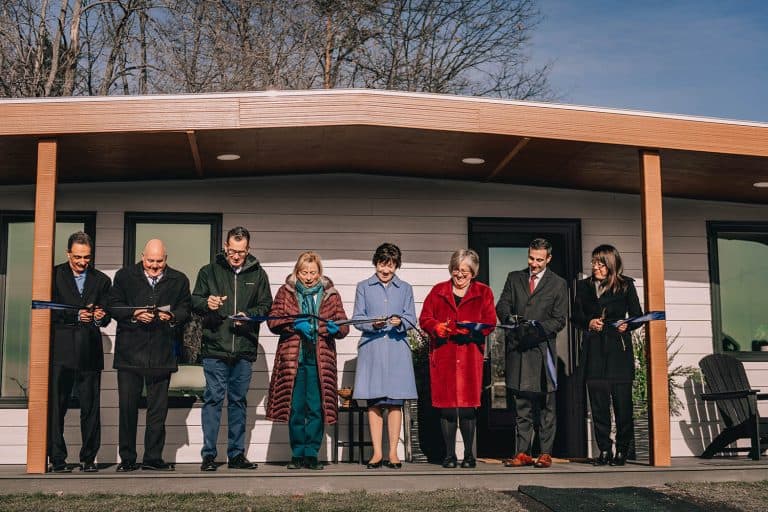On November 21st, researchers at the University of Maine Advanced Structures and Composites Center (ASCC) presented the world’s first Bio-based 3D printed home, composed of 100 percent bio materials.
The house, named “BioHome 3D” is described as a potential climate-friendly response to the nation’s affordable housing crisis. The ASCC was able to advance this project with funding and help from the US Department of Energy and the Oak Ridge National Laboratory.
The unveiling event and cutting ceremony was attended by Governor Janet Mills, U.S. Senator Susan Collins; Jeff Marootian, senior advisor renewable energy and efficiency at the US department of energy, Steve McKnight, acting advanced manufacturing office director at the DOE, and others members/leaders from the US department of energy.
The 600-square-foot house consists of 3D printed floors, walls, and a roof made of wood fiber and bio-resin. The main material is identified as wood flour which is substantively the waste leftover from a sawmill combined together with a binder made from corn.
“There’s 1.2 million tons of wood residuals in our sawmills right now in the region that could go to print housing,” said Dr.Habib Dagher, executive director of the University’s Advanced Structures and Composites Center. In addition, the precision of the printing process suppressed most construction waste, officials said.
The exterior of BioHome 3D resembles most modern-day construction. The only visible difference is the appearance of the curved roof, and the rounded corners of the home. Whereas the interior of the house offers a doorway leading to a small living room and an open kitchen with appliances. There is also a hallway that leads to a furnished bedroom and bathroom.
The floor, walls, and roof of BioHome 3D were all created with the University’s 3D printer. In addition, the house is fully recyclable and contains 100% wood insulation.
As the United States faces a crisis-level shortage of affordable housing, the 3D printed home technology offers a solution to the urgent national need. The state of Maine in particular is undergoing a continuous increase of shortage in housing units.
The national low income housing coalition has announced that Maine is short of 20,000 housing units. Most underproduction is evident in the metropolitan area of Portland- South Portland. An approximate 60% of low-income Maine renters spend more than half of their income on housing. The unsustainable situation is intensified by the obstacles of labor shortage and the persistent price increase of the supply chain.
The technology is aimed to tackle labor shortages and concerns with supply chains that are resulting in high costs and narrowing the supply of economical housing.
“This has the potential to help us with the homeless population, the homeless problem. Not this winter, because it’s not ready to be mass produced yet,” Mills said. “But once we get our factory of the future up and running, we will be able to produce homes of this sort.”
With this technology, consumers are promised fast delivery of affordable housing that can be customized to meet their aesthetic choices, and desired space in a timely manner. “The goal is to print one of these homes within two days”, said Dagher.
“This remarkable accomplishment was made possible by the tenacity and expertise of Dr. Habib Dagher, his team and students at the UMaine Advanced Structures and Composites Center. I commend them on pioneering this new market opportunity for Maine’s forest products industry, which could help alleviate our nation’s housing shortage. Their groundbreaking work will lay the foundation for the future of affordable housing and help create new jobs across our state”, said sen. Collins.
The ASCC was able to advance this project with funding from the US Department of Energy and the Oak Ridge National Laboratory.
This story was originally published by Maine Public and UMaine News.


